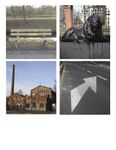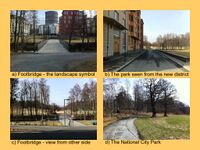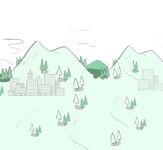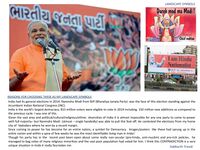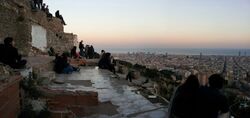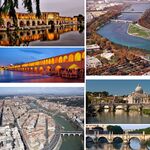LED Seminar 2016 - Landscape Symbols Reflection Group H
Landscape Symbol 1- Gliwice Poland, Nicolas Reibel
Representations and analytical drawings
in addition to your initial visual please add two further analytical drawings of your symbol
- GroupI slide2.JPG
slide 2
- GroupI slide3.JPG
slide 3
Reflections
Please write a 250 words text reflecting on the following questions, you can also take ideas from your group members into account
- How and why did the symbols you identify appear in your landscape?
- Did their meaning change along with socio-political, economic, environmental or cultural changes in your region, or country?
- What do these symbols mean to you today? Are they meaningful to more than just one cultural group? Are they shared across cultures?
What is most important about this bench is the direction it faces. None of the benches in the city face the Kłodnica River, which bisects Gliwice. A major feature of the landscape, goes unnoticed on a daily basis. The bench stands as a symbol of “the gaze”, determining which landscapes have value. This highly polluted river is a point of shame for both the populace and the municipality. Neither group has addressed the issue, which lends to the bench's symbol of inaction.
The lion was brought to the city center, after initially being installed in front of the local steel mill. The mill has since shut down. The lion has a unique meaning to the populace, as they were displaced from their former home, Lviv Ukraine, and forced to reestablish themselves here in Gliwice, a former German city. Lviv is known as the city of the lion, and it's name relates to the Polish word for lion “lew.”
The merge symbol is taken from the on-ramp to the newly finished intercity highway (DTS) which links the major cities of the Silesian region. This new infrastructure ties the landscape, economies and communities together, merging the previously independent municipalities. These changes mirror another important merger, Poland's admission to the EU, which has greatly impacted the local economy. It even subsidized the DTS project.
This former factory is now a cultural space for music and exhibitions. These red brick structures litter the landscape, a majority abandoned, some appropriated for other means. They signify the former blue collar – industrial identity of the city. The red brick architecture in the city is often identified by the citizens as “German”, and emphasize that it originated from another culture. These buildings undoubtedly have another identity for the German tourists who visit the region in the summer.
Landscape Symbol 2- Stockholm, Emil Buzzi
Representations and analytical drawings
in addition to your initial visual please add two further analytical drawings of your symbol
- GroupI slide2.JPG
slide 2
- GroupI slide3.JPG
slide 3
Reflections
Please write a 250 words text reflecting on the following questions, you can also take ideas from your group members into account
- How and why did the symbols you identify appear in your landscape?
- Did their meaning change along with socio-political, economic, environmental or cultural changes in your region, or country?
- What do these symbols mean to you today? Are they meaningful to more than just one cultural group? Are they shared across cultures?
What is most important about this bench is the direction it faces. None of the benches in the city face the Kłodnica River, which bisects Gliwice. A major feature of the landscape, goes unnoticed on a daily basis. The bench stands as a symbol of “the gaze”, determining which landscapes have value. This highly polluted river is a point of shame for both the populace and the municipality. Neither group has addressed the issue, which lends to the bench's symbol of inaction.
The lion was brought to the city center, after initially being installed in front of the local steel mill. The mill has since shut down. The lion has a unique meaning to the populace, as they were displaced from their former home, Lviv Ukraine, and forced to reestablish themselves here in Gliwice, a former German city. Lviv is known as the city of the lion, and it's name relates to the Polish word for lion “lew.”
The merge symbol is taken from the on-ramp to the newly finished intercity highway (DTS) which links the major cities of the Silesian region. This new infrastructure ties the landscape, economies and communities together, merging the previously independent municipalities. These changes mirror another important merger, Poland's admission to the EU, which has greatly impacted the local economy. It even subsidized the DTS project.
This former factory is now a cultural space for music and exhibitions. These red brick structures litter the landscape, a majority abandoned, some appropriated for other means. They signify the former blue collar – industrial identity of the city. The red brick architecture in the city is often identified by the citizens as “German”, and emphasize that it originated from another culture. These buildings undoubtedly have another identity for the German tourists who visit the region in the summer.
Landscape Symbol 3- Maliheh Shahghadami
Representations and analytical drawings
in addition to your initial visual please add two further analytical drawings of your symbol
- GroupI slide2.JPG
slide 2
- GroupI slide3.JPG
slide 3
Reflections
Please write a 250 words text reflecting on the following questions, you can also take ideas from your group members into account
- How and why did the symbols you identify appear in your landscape?
- Did their meaning change along with socio-political, economic, environmental or cultural changes in your region, or country?
- What do these symbols mean to you today? Are they meaningful to more than just one cultural group? Are they shared across cultures?
add your text here
Landscape Symbol 4- Nardena Modi, Siddharth Trivedi
Representations and analytical drawings
in addition to your initial visual please add two further analytical drawings of your symbol
- GroupI slide2.JPG
slide 2
- GroupI slide3.JPG
slide 3
Reflections
Please write a 250 words text reflecting on the following questions, you can also take ideas from your group members into account
- How and why did the symbols you identify appear in your landscape?
- Did their meaning change along with socio-political, economic, environmental or cultural changes in your region, or country?
- What do these symbols mean to you today? Are they meaningful to more than just one cultural group? Are they shared across cultures?
add your text here
Landscape Symbol 5-Turo Rovira Barcelona, Margherita Galante
Representations and analytical drawings
in addition to your initial visual please add two further analytical drawings of your symbol
- GroupI slide2.JPG
slide 2
- GroupI slide3.JPG
slide 3
Reflections
Please write a 250 words text reflecting on the following questions, you can also take ideas from your group members into account
- How and why did the symbols you identify appear in your landscape?
- Did their meaning change along with socio-political, economic, environmental or cultural changes in your region, or country?
- What do these symbols mean to you today? Are they meaningful to more than just one cultural group? Are they shared across cultures?
add your text here
Landscape Symbol 6-Rivers, Reihaneh Rafiemanzelat
Representations and analytical drawings
in addition to your initial visual please add two further analytical drawings of your symbol
- GroupI slide2.JPG
slide 2
- GroupI slide3.JPG
slide 3
Reflections
Please write a 250 words text reflecting on the following questions, you can also take ideas from your group members into account
- How and why did the symbols you identify appear in your landscape?
- Did their meaning change along with socio-political, economic, environmental or cultural changes in your region, or country?
- What do these symbols mean to you today? Are they meaningful to more than just one cultural group? Are they shared across cultures?
add your text here
Group reflection
Please add a summary of your group reflection here
